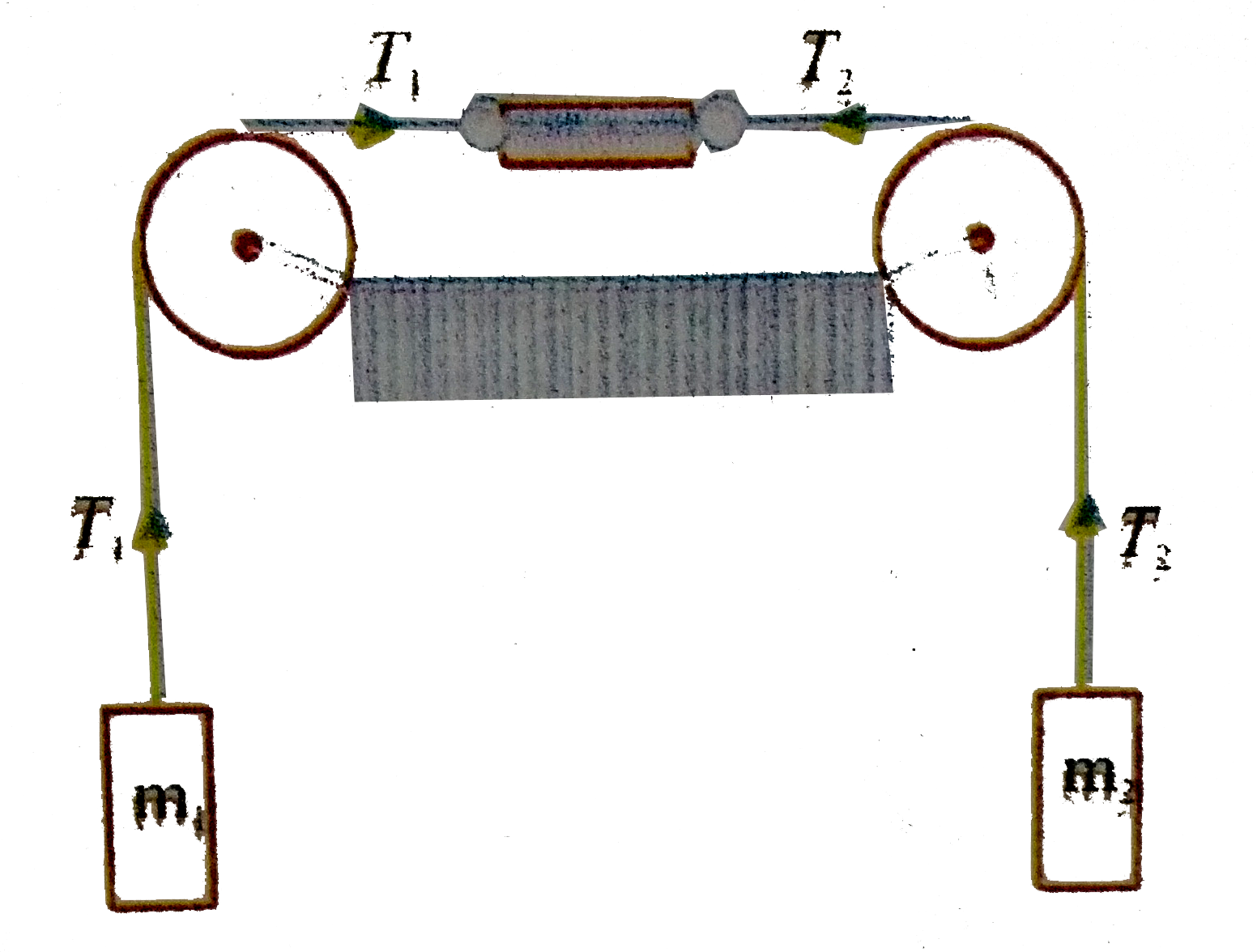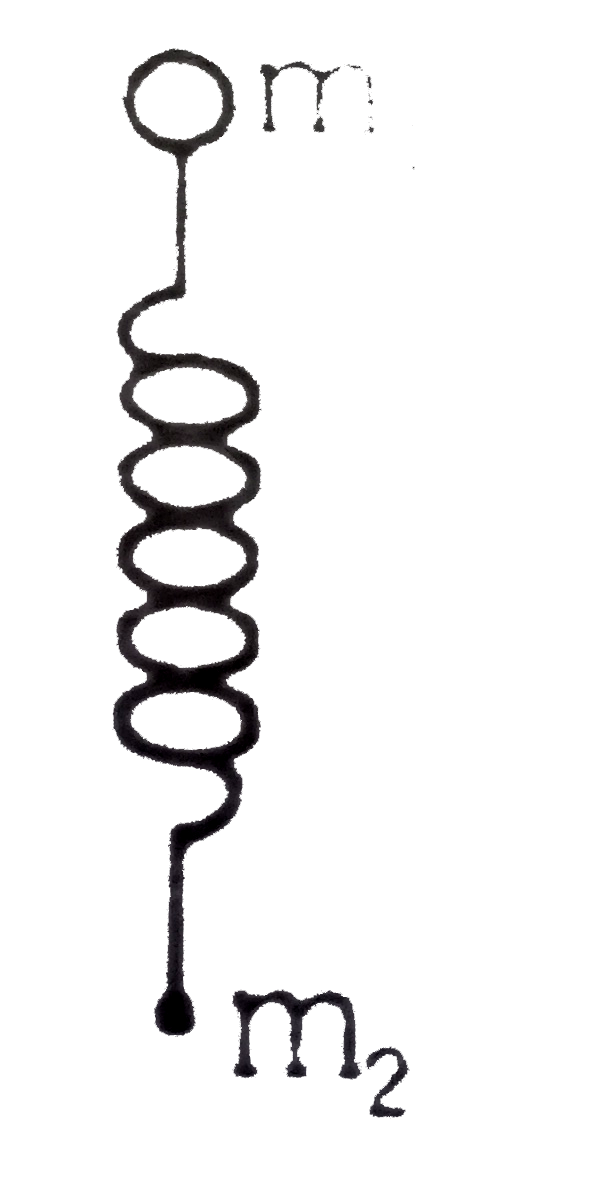Two light trollwys of masses m1 and m2(=3m1) are connected by a spring. The spring is compressed and bound by a cord. The cord is burnt through, the spring expands and the trolleys move off in opposite direction. Assume that the coefficient of friction is the same for both trollwys.
 Solution in Gujrati
Solution in Gujrati
The relationship between the velocties v1 and v2 of the trolleys is v1/v2=3
The relationship between the periods t1 and t2 during which the trolleys move t1/t2=3
The relationship between the distance s1 and s2 travelled by the trolleys is s1/s2=3
The relationship between the force of friction f1 and f2 acting on the two trolleys is f1/f2=13
The correct Answer is:A, B, D
Step by step video & image solution for Two light trollwys of masses m_(1) and m_(2) (= 3m_(1)) are connected by a spring. The spring is compressed and bound by a cord. The cord is burnt through, the spring expands and the trolleys move off in opposite direction. Assume that the coefficient of friction is the same for both trollwys. by Physics experts to help you in doubts & scoring excellent marks in Class 11 exams.
Topper's Solved these Questions
- BOOK - ALLEN CHAPTER - CENTRE OF MASSEXERCISE - EXERCISE-III41videos
CENTRE OF MASS
- BOOK - ALLEN CHAPTER - CENTRE OF MASSEXERCISE - EXERCISE-IV A32videos
CENTRE OF MASS
- BOOK - ALLEN CHAPTER - CENTRE OF MASSEXERCISE - EXERCISE-I40videos
CENTRE OF MASS
- BOOK - ALLEN CHAPTER - BASIC MATHEMATICS USED IN PHYSICS &VECTORS EXERCISE - EXERCISE-IV ASSERTION & REASON11videos
BASIC MATHEMATICS USED IN PHYSICS &VECTORS
- BOOK - ALLEN CHAPTER - ELASTICITY, SURFACE TENSION AND FLUID MECHANICSEXERCISE - Exercise 5 B (Integer Type Questions)3videos
ELASTICITY, SURFACE TENSION AND FLUID MECHANICS
Similar Questions
A particle of mass m, kinetic energy K and momentum p collision head on elastically with another particle of mass 2m at rest. After collision. :
Column IColumn II(A)Momentum of first particle(p)3/4p(B)Momentum of second particle(q)−K/9(C)Kinetic energy of first particle(r)−p/3(D)Kinetic energy of second particle(s)8K9None01:42View SolutionFig. shown a uniform square plate from identical squares at the corners can be removed. (a) Where is the centre of mass of the plate originally ? (b) Where is it after square 1 is removed ?
(c ) where is it after squares 1 and 2 are removed ? (d) Where is c.m after squares 1,2,3, are removed ?
(f) Where is c.m after all the four squares are removed ? Answer in terms of quadrants and axes.
 03:01View Solution
03:01View SolutionThe centre of mass of a non uniform rod of length L whoose mass per unit length varies as p=kx2/L, (where k is a constant and x is the distance measured form one end) is at the following distances from the same end
03:37View SolutionAssertion: If the initial and final positions coincide, the displacement is a null vector.
Reason: A physical quantity can not be called a vector, if its magnitude is zero.04:41View SolutionTwo soap bubbles A and B are kept in a closed chamber where the air is maintained at pressure 8N/m2.The radii of bubbles A and B are 2cm and 4cm, respectively. Surface tension of the soap-water used to make bubbles is 0.04N/m. Find tha ratio nB/nA, where nA and nB are the number of moles of air in bubbles A and B, respectively. [Neglect the effect of gravity.]
04:01View SolutionTwo unequal masses are ties together with a cord with a compressed spring in between. When the cord is burnt with a match releasing the spring, the two masses fly apart with equal
01:26View SolutionA spring connects two particles of masses m1 and m2 A horizontal force F acts on m1 Ignoring friction when the elongation of the spring is x then [when the spring has maximum elongation]
 .03:39View Solution
.03:39View SolutionTwo masses m1 and m2 are attached to a spring balance S as shown in figure. m1>m2 then the reading of spring balance will be .
 .03:01View Solution
.03:01View SolutionTwo trolleys of mass m and 3 m are attached by a spring. The spring was compressed and then released , they move off in opposite direction and comes to rest after covering distances s_(1) and s_(2) respectively. Assuming the coefficient of friction to be uniform , the ratio of distances s_(1) : s_(2) is
View SolutionTwo blocks of masses m_(1) and m_(2) are kept on a smooth horizontal table as shown in figure. Block of mass m_(1) (but not m_(2) is fastened to the spring. If now both the blocks are pushed to the left so that the spring is compressed a distance d. The amplitude of oscillatin of block of mass m_(1) after the system is released is
View SolutionThe two masses m1 and m2 are joined by a spring as shown. The system is dropped to the ground from a height. The spring will be
 View Solution
View SolutionTwo bars of masses m_(1) and m_(2) , connected by light underformed horizontal spring are lying on a uniformly rough horizontal surface, having coefficient of friction mu . The minimum constant force that has to be applied horizontal to the bar m_(1) along the length of the spring, in order to just shift the other bar m_(2) is
View SolutionTwo trolleys of masses m and 3 m are connected by aspring. The spring is compressed and released the trolleys move off in opposite directions and come to rest after travelling distances s, and s, respectively. Assuming coefficient of friction is same for both the ratio of sto s1 to s2 is
View SolutionTwo masses m_(1) and m_(2) are attached to a spring balance S as shown in Figure. If m_(1)gt m_(2) then the reading of spring balance will be
View SolutionTwo trolleys of masses m and 3m are connected by a spring. They are compressed and released, they move off in opposite direction and come to rest after covering distances s_(1) and s_(2) respectively. If the frictional force between trolley and surface is same in both the cases then the ratio of distances s_(1):s_(2) is
03:01View SolutionTwo blocks of masses m1 and m2 are connected by a spring having spring constant K. Initially , the spring is at its natural length. The coefficient of friction between the blocks and the surface is μ. What minimum constant force has to be applied in the horizontal direction to the block of mass m1, in order to shift the other block ?
02:50View Solution

